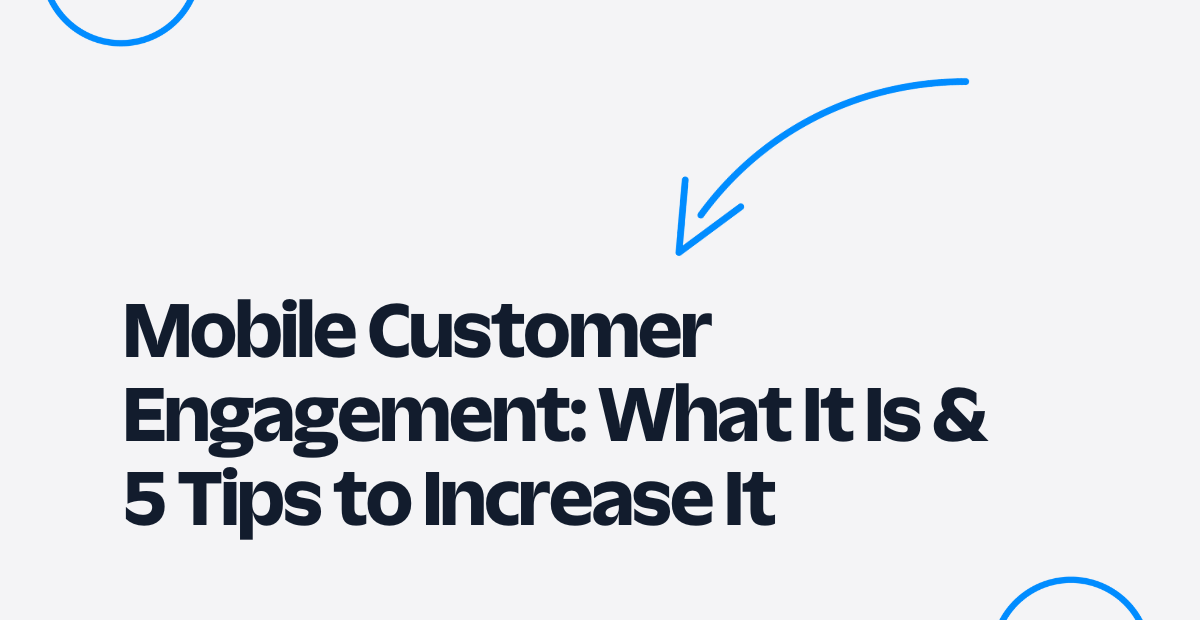Mobile Customer Engagement: What It Is & 5 Tips to Increase It
Time to read: 5 minutes

Customer engagement used to happen largely in person and on the phone. But today, more and more interactions between customers and businesses happen on mobile channels. You’ll find customers placing orders on their smartphones, connecting with customer support via live chat, and more.
Regardless of the channel, providing a positive experience helps nurture customer loyalty and maintain brand awareness, ultimately driving revenue for your business.
However, the best practices for customer engagement on mobile channels differ from traditional, nondigital channels. So how do you make the most of customer interactions on mobile apps?
This post will answer that and more, explaining what mobile customer engagement is, why it matters, and how to improve it.
What is mobile customer engagement?
Mobile customer engagement refers to the interactions between your business and customers via mobile channels, such as messaging apps and webchat. This includes conversational marketing, real-time messaging, and other digital channels that customers access on mobile devices.
One of the benefits of mobile channels is the ability to help nurture your relationship with customers while being convenient for both parties. For example, businesses can leverage tools like chatbots to cut down agents’ workloads while swiftly resolving customers’ issues. Meanwhile, customers can connect with businesses on their most convenient platforms.
Why does good mobile customer engagement matter?
Customers value convenient communication, and this starts with contacting businesses on their preferred channels, like mobile apps and messaging platforms.
Plus, meeting customers on these channels ultimately leads to higher revenue for businesses. Want some proof? Here’s what we found in our 2022 State of Customer Engagement Report:
- Businesses that invested in digital customer engagement saw top-line revenue rise by an average of 70%. (In 2023, that number went up to 90%.)
- Business-to-consumer companies reported that over half of customer engagement happens on digital channels.
- Businesses saw digital interactions on Twilio platforms triple over the past 3 years, including on channels like email, messaging, video, and voice.
Now that you have an idea of the prevalence of mobile customer engagement, let’s look at how you can improve it.
How do you increase customer engagement on mobile channels?
Try these 5 tips to increase customer engagement on mobile apps, messaging platforms, and other digital channels.
1. Personalize every interaction
There’s one thing 98% of companies and 83% of consumers agree on: personalization increases customer engagement.
But a truly personalized experience goes beyond addressing the customer by name. The key to personalization is understanding the customer’s entire journey with your business to provide the customized support they need.
So how do you achieve this level of personalization? One of the most important steps you can take is integrating your mobile customer engagement platforms with the right tools.
For example, a nonprofit organization can connect its messaging platform with a customer relationship management (CRM) software like Salesforce to engage donors with personalized communications based on context like recent donations.
Additionally, businesses can integrate a customer data platform (CDP) like Twilio Segment to give employees access to real-time, in-depth customer data—like past purchases and web pages viewed—for fully personalized engagement.
2. Streamline the user experience
A negative customer experience can quickly turn away a loyal customer. In fact, 56% of consumers admit a poor interaction would prevent them from doing further business with a company.
This illustrates how vital it is to provide a seamless user experience across channels, including your mobile app and messaging platforms. And a good experience begins with a user-friendly flow that helps customers get the support they need as quickly as possible.
For example, this tutorial uses Twilio Frontline and a chatbot to build a customer service solution that connects the user with an expert after just a few messages. The customer only needs to send the email address of the expert they want to speak to or request an agent, and the bot will connect them to the right person.
3. Provide easy access to customer support across channels
Trying to hunt down a customer support phone number or email address buried in the depths of your website footer will only frustrate customers. And as we’ve already seen, frustration can lead to losing a customer altogether.
So make it easy for them to connect with your business on any channel, particularly the ones they access from mobile devices, with well-placed links and easy-to-find buttons. Here are a few ways to do this:
- Place a Live chat button in a convenient spot on your website (typically the bottom-right corner), like Yembo does in the example below.
- Link to an over-the-top messaging app, like WhatsApp, from an icon in your email footer.
- Add an accessible Call customer support button on your mobile app.

By making it easy for customers to reach you, you’ll be well on your way to providing a positive experience—as long as agents have the tools to serve them efficiently (as we’ll discuss next).
4. Create a seamless experience for employees
Your employees—like customer service agents, sales representatives, and other customer-facing roles—can only provide a positive, personalized customer experience when you equip them with the necessary resources. This includes easy-to-navigate applications integrated with the right tools, so they can:
- Pull up the context of a customer’s previous interactions
- Transfer customers to other team members easily without losing that context
- Track customer data in real time
Luckily, you don’t have to build an app from scratch to make this possible. Ready-to-use apps like Frontline give you a head start to help you deploy and customize your solution quickly and empower employees to engage customers on mobile platforms better.
5. Use multimedia elements
A unique feature of mobile channels is the ability to use multimedia elements. For example, with messaging apps, agents and customers can send photos, videos, and emojis to help streamline communication when words aren't enough.
Not sure how to incorporate multimedia elements into your customer interactions? Here are a few ideas of what you can do:
- Add photos and GIFs to marketing messages
- Share video tutorials via live chat
- Ask customers to send a photo or screenshot to help illustrate their issue
- Send property photos and video tours to real estate customers
- And more
These tactics can help keep customers engaged and create clearer communication by taking advantage of digital channel capabilities.
Engage customers on mobile channels with Twilio Frontline
If you’re looking for a mobile app that’ll help employees engage with customers better, Frontline can help. You can quickly deploy this programmable, ready-to-use app for various use cases, like sales and relationship management with clients or donors.
Frontline also supports cross-channel messaging, so you can connect with customers on WhatsApp, SMS, MMS, chat, and voice. Plus, you can integrate the app with your CRM or CDP to give employees the necessary context to create personalized experiences. And if your business handles personal health information, you can manage data privacy and ensure your application complies with the appropriate regulations.
Does this sound like the solution for you? Learn more about Frontline and try it for free today.
Related Posts
Related Resources
Twilio Docs
From APIs to SDKs to sample apps
API reference documentation, SDKs, helper libraries, quickstarts, and tutorials for your language and platform.
Resource Center
The latest ebooks, industry reports, and webinars
Learn from customer engagement experts to improve your own communication.
Ahoy
Twilio's developer community hub
Best practices, code samples, and inspiration to build communications and digital engagement experiences.



